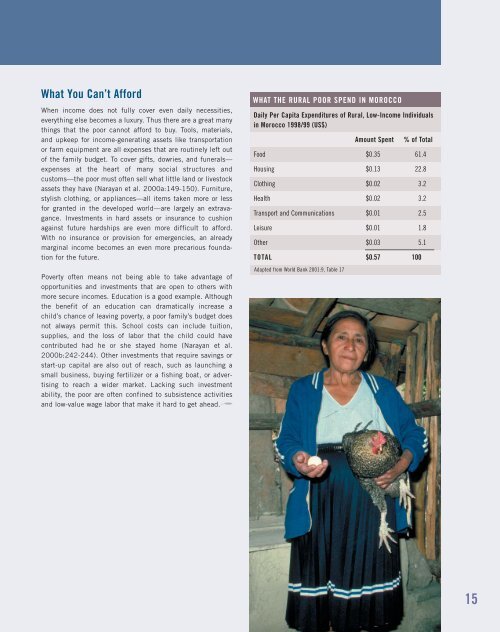jp8589 WRI.qxd - World Resources Institute
jp8589 WRI.qxd - World Resources Institute
jp8589 WRI.qxd - World Resources Institute
Create successful ePaper yourself
Turn your PDF publications into a flip-book with our unique Google optimized e-Paper software.
What You Can’t Afford<br />
When income does not fully cover even daily necessities,<br />
everything else becomes a luxury. Thus there are a great many<br />
things that the poor cannot afford to buy. Tools, materials,<br />
and upkeep for income-generating assets like transportation<br />
or farm equipment are all expenses that are routinely left out<br />
of the family budget. To cover gifts, dowries, and funerals—<br />
expenses at the heart of many social structures and<br />
customs—the poor must often sell what little land or livestock<br />
assets they have (Narayan et al. 2000a:149-150). Furniture,<br />
stylish clothing, or appliances—all items taken more or less<br />
for granted in the developed world—are largely an extravagance.<br />
Investments in hard assets or insurance to cushion<br />
against future hardships are even more difficult to afford.<br />
With no insurance or provision for emergencies, an already<br />
marginal income becomes an even more precarious foundation<br />
for the future.<br />
Poverty often means not being able to take advantage of<br />
opportunities and investments that are open to others with<br />
more secure incomes. Education is a good example. Although<br />
the benefit of an education can dramatically increase a<br />
child’s chance of leaving poverty, a poor family’s budget does<br />
not always permit this. School costs can include tuition,<br />
supplies, and the loss of labor that the child could have<br />
contributed had he or she stayed home (Narayan et al.<br />
2000b:242-244). Other investments that require savings or<br />
start-up capital are also out of reach, such as launching a<br />
small business, buying fertilizer or a fishing boat, or advertising<br />
to reach a wider market. Lacking such investment<br />
ability, the poor are often confined to subsistence activities<br />
and low-value wage labor that make it hard to get ahead.<br />
WHAT THE RURAL POOR SPEND IN MOROCCO<br />
Daily Per Capita Expenditures of Rural, Low-Income Individuals<br />
in Morocco 1998/99 (US$)<br />
Amount Spent<br />
% of Total<br />
Food $0.35 61.4<br />
Housing $0.13 22.8<br />
Clothing $0.02 3.2<br />
Health $0.02 3.2<br />
Transport and Communications $0.01 2.5<br />
Leisure $0.01 1.8<br />
Other $0.03 5.1<br />
TOTAL $0.57 100<br />
Adapted from <strong>World</strong> Bank 2001:9, Table 17<br />
15

















